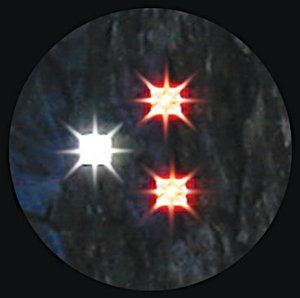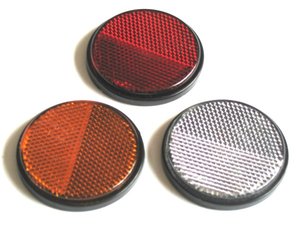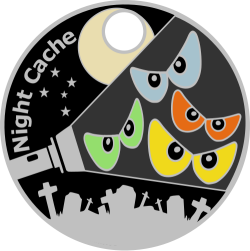Difference between revisions of "Night cache"
Caughtatwork (talk | contribs) |
Caughtatwork (talk | contribs) |
||
| (4 intermediate revisions by the same user not shown) | |||
| Line 1: | Line 1: | ||
| + | {{GCA}} | ||
[[Image:Firetacks.jpg|300px|right]] [[Image:Reflectors.jpg|300px|right]] | [[Image:Firetacks.jpg|300px|right]] [[Image:Reflectors.jpg|300px|right]] | ||
| + | ==Night cache== | ||
A [[Night cache]] is a sub type of [[multi-cache]] that can only be achieved after dark. | A [[Night cache]] is a sub type of [[multi-cache]] that can only be achieved after dark. | ||
| + | |||
| + | Unlike "Night Caches" which are listed on other listing sites, there is no mandatory requirement for you to need your GPS after you have started the Night Cache course. Of course, if the geocache owner decides to make you use your GPS that's up to them, but there is no mandatory requirement for GPS use. It can be all reflectors to find the cache once you have reached the starting point. This removes the irritation of interrupting your Night Cache course to comply with an arbitrary rule about GPS usage. | ||
Traditionally night caching uses reflective trail markers to lead you to a cache, but any method of navigation that can only be achieved after dark can also be used for a Night Cache. The coordinates given on the geocache page will generally take you to the starting point for the geocache. From there you need to find the method of navigating the course to get to the geocache. Something like looking for the reflective trail markers (FireTacks) is what can be generally assumed for a night cache. They would different to a typical [[multi-cache]] where you enter additional co-ordinates and navigate to. They might be [[http://www.firetacks.com/ fire tacks]] places on trees, stumps, rocks or other items in your path. They might be like road reflectors which you can bounce your torch light of in the distance. They may be reflective tape placed around something that you would need an additional light source to activate. | Traditionally night caching uses reflective trail markers to lead you to a cache, but any method of navigation that can only be achieved after dark can also be used for a Night Cache. The coordinates given on the geocache page will generally take you to the starting point for the geocache. From there you need to find the method of navigating the course to get to the geocache. Something like looking for the reflective trail markers (FireTacks) is what can be generally assumed for a night cache. They would different to a typical [[multi-cache]] where you enter additional co-ordinates and navigate to. They might be [[http://www.firetacks.com/ fire tacks]] places on trees, stumps, rocks or other items in your path. They might be like road reflectors which you can bounce your torch light of in the distance. They may be reflective tape placed around something that you would need an additional light source to activate. | ||
| Line 10: | Line 14: | ||
A [[Night cache]] should not be able to be completed during the day. i.e. The method of following the laid out course should only be able to be achieved after dark. | A [[Night cache]] should not be able to be completed during the day. i.e. The method of following the laid out course should only be able to be achieved after dark. | ||
| + | |||
| + | ==Hints, Tips and Tricks== | ||
| + | Night caches can be quite maintenance intensive. If you place two or even three reflectors at each point, you decrease the chances of all of them being dislodged by Possums or obscured by foliage. Tacks pushed into tree bark often fall out so suspending at least one reflector is good insurance.<br /> | ||
| + | A number of cachers are red/green colour blind and have trouble seeing red, orange and brown reflectors. If you want to be as inclusive as possible, choose colours other than those.<br /> | ||
| + | Thanks to Facebook poster Mark D'Elton for these thoughts. | ||
| + | |||
| + | The basics that i used was to ensure that the tacs were placed near enough so that you could see atleast 1 or 2 ahead of where you are and ensuring that its not to long or short and using a decent container at the end.<br /> | ||
| + | Thanks to Facebook poster Brad Kellam for this thought. | ||
| + | |||
| + | ==Technical== | ||
| + | A Night Cache should show up on your GPS as a multi cache.<br /> | ||
| + | The GA Cacher app should show a Night cache up on your device as a Night Cache [[Image:cacheicon_nightcache.png]]<br /> | ||
==Examples== | ==Examples== | ||
| Line 17: | Line 33: | ||
==See Also== | ==See Also== | ||
* [[Cache type]]s | * [[Cache type]]s | ||
| + | |||
| + | ==Competition== | ||
| + | [[Image:Night_Cache_Pathtag_250.png|250px|right]] | ||
| + | From 1 October 2015 through to 29 February 2016 (AEDST) inclusive, Geocaching Australia is running a competition in line with the announcement of the new Night Cache type at Geocaching Australia. | ||
| + | |||
| + | The top 3 Night Caches in each Australian state and territory will be awarded a specially minted pathtag that will not be available for sale. The only chance you have of getting hold of one is to be a prize winner or trade with those who have won a prize. | ||
| + | |||
| + | ===Competition Prizes=== | ||
| + | * 1st place in each state and territory will win 3 of these pathtags. | ||
| + | * 2nd place in each state and territory will win 2 of these pathtags. | ||
| + | * 3rd place in each state and territory will win 1 of these pathtags. | ||
| + | |||
| + | Any unclaimed prizes go into a second round random prize draw. | ||
| + | |||
| + | ===Winner Calculation=== | ||
| + | The method of identifying the winners will be the same as the calculation for the Cache of the Year leaderboard.<br /> | ||
| + | Sum of the individual ratings * 3 (where a rating 1 = -2, 2 = -1, 3 = 3, 4 = 8, 5 = 10)<br /> | ||
| + | PLUS<br /> | ||
| + | count of recommendations * 20<br /> | ||
| + | PLUS<br /> | ||
| + | difficulty * 5<br /> | ||
| + | PLUS<br /> | ||
| + | terrain * 10<br /> | ||
| + | |||
| + | ===Competition Rules=== | ||
| + | * You may enter as many Night Caches as you wish. | ||
| + | * You may only win 1 of any of the 3 prizes in an Australian state or territory. | ||
| + | * Your cache must be a night cache. i.e. must be in line with this wiki entry on Night Caches. | ||
| + | * Your cache must be active and findable on the day the competition closes. | ||
| + | * Your cache can be entered into the competition any time up to the close of the competition. | ||
| + | * All Night Caches are considered automatically entered into the competition. | ||
| + | * Your cache MUST be unique to Geocaching Australia with no cross listings. | ||
| + | * You should not beg for ratings or recommendations in your cache listing. A good quality cache will stand on its merits. | ||
| + | * Accounts which are created for the purpose of increasing points on a competition cache will disqualify the cache from contention. Cheating is not in the spirit of geocaching or the competition. | ||
| + | * You are encouraged to seek out and recruit geocachers to join Geocaching Australia provided they are not joining JUST to find your Night cache entry. | ||
| + | |||
| + | ===Disclaimer=== | ||
| + | The decision of the competition organiser is final and no correspondence will be entered into. | ||
Latest revision as of 15:58, 1 October 2015
| This page contains information specific to Geocaching Australia. |
Contents
Night cache
A Night cache is a sub type of multi-cache that can only be achieved after dark.
Unlike "Night Caches" which are listed on other listing sites, there is no mandatory requirement for you to need your GPS after you have started the Night Cache course. Of course, if the geocache owner decides to make you use your GPS that's up to them, but there is no mandatory requirement for GPS use. It can be all reflectors to find the cache once you have reached the starting point. This removes the irritation of interrupting your Night Cache course to comply with an arbitrary rule about GPS usage.
Traditionally night caching uses reflective trail markers to lead you to a cache, but any method of navigation that can only be achieved after dark can also be used for a Night Cache. The coordinates given on the geocache page will generally take you to the starting point for the geocache. From there you need to find the method of navigating the course to get to the geocache. Something like looking for the reflective trail markers (FireTacks) is what can be generally assumed for a night cache. They would different to a typical multi-cache where you enter additional co-ordinates and navigate to. They might be [fire tacks] places on trees, stumps, rocks or other items in your path. They might be like road reflectors which you can bounce your torch light of in the distance. They may be reflective tape placed around something that you would need an additional light source to activate.
Reflectors are not always as easy to see as you may assume. Fire tacks and other types of reflectors are retro-reflective. This means they shine back towards the light source. If you hold the light source low they reflect back to that low point. For best results hold your light at eye level or use a head lamp. In this manner the light is reflected back to the source which is in line with your eyes.
Other types of navigation may use lasers, UV, glow in the dark, shine through, shine on and even braille (after all you're doing this without the aid of usual light sources). Trying a night cache might open up your geocaching activities to a whole new experience. One we think you’ll enjoy.
A Night cache should not be able to be completed during the day. i.e. The method of following the laid out course should only be able to be achieved after dark.
Hints, Tips and Tricks
Night caches can be quite maintenance intensive. If you place two or even three reflectors at each point, you decrease the chances of all of them being dislodged by Possums or obscured by foliage. Tacks pushed into tree bark often fall out so suspending at least one reflector is good insurance.
A number of cachers are red/green colour blind and have trouble seeing red, orange and brown reflectors. If you want to be as inclusive as possible, choose colours other than those.
Thanks to Facebook poster Mark D'Elton for these thoughts.
The basics that i used was to ensure that the tacs were placed near enough so that you could see atleast 1 or 2 ahead of where you are and ensuring that its not to long or short and using a decent container at the end.
Thanks to Facebook poster Brad Kellam for this thought.
Technical
A Night Cache should show up on your GPS as a multi cache.
The GA Cacher app should show a Night cache up on your device as a Night Cache ![]()
Examples
- any others?
See Also
Competition
From 1 October 2015 through to 29 February 2016 (AEDST) inclusive, Geocaching Australia is running a competition in line with the announcement of the new Night Cache type at Geocaching Australia.
The top 3 Night Caches in each Australian state and territory will be awarded a specially minted pathtag that will not be available for sale. The only chance you have of getting hold of one is to be a prize winner or trade with those who have won a prize.
Competition Prizes
- 1st place in each state and territory will win 3 of these pathtags.
- 2nd place in each state and territory will win 2 of these pathtags.
- 3rd place in each state and territory will win 1 of these pathtags.
Any unclaimed prizes go into a second round random prize draw.
Winner Calculation
The method of identifying the winners will be the same as the calculation for the Cache of the Year leaderboard.
Sum of the individual ratings * 3 (where a rating 1 = -2, 2 = -1, 3 = 3, 4 = 8, 5 = 10)
PLUS
count of recommendations * 20
PLUS
difficulty * 5
PLUS
terrain * 10
Competition Rules
- You may enter as many Night Caches as you wish.
- You may only win 1 of any of the 3 prizes in an Australian state or territory.
- Your cache must be a night cache. i.e. must be in line with this wiki entry on Night Caches.
- Your cache must be active and findable on the day the competition closes.
- Your cache can be entered into the competition any time up to the close of the competition.
- All Night Caches are considered automatically entered into the competition.
- Your cache MUST be unique to Geocaching Australia with no cross listings.
- You should not beg for ratings or recommendations in your cache listing. A good quality cache will stand on its merits.
- Accounts which are created for the purpose of increasing points on a competition cache will disqualify the cache from contention. Cheating is not in the spirit of geocaching or the competition.
- You are encouraged to seek out and recruit geocachers to join Geocaching Australia provided they are not joining JUST to find your Night cache entry.
Disclaimer
The decision of the competition organiser is final and no correspondence will be entered into.



